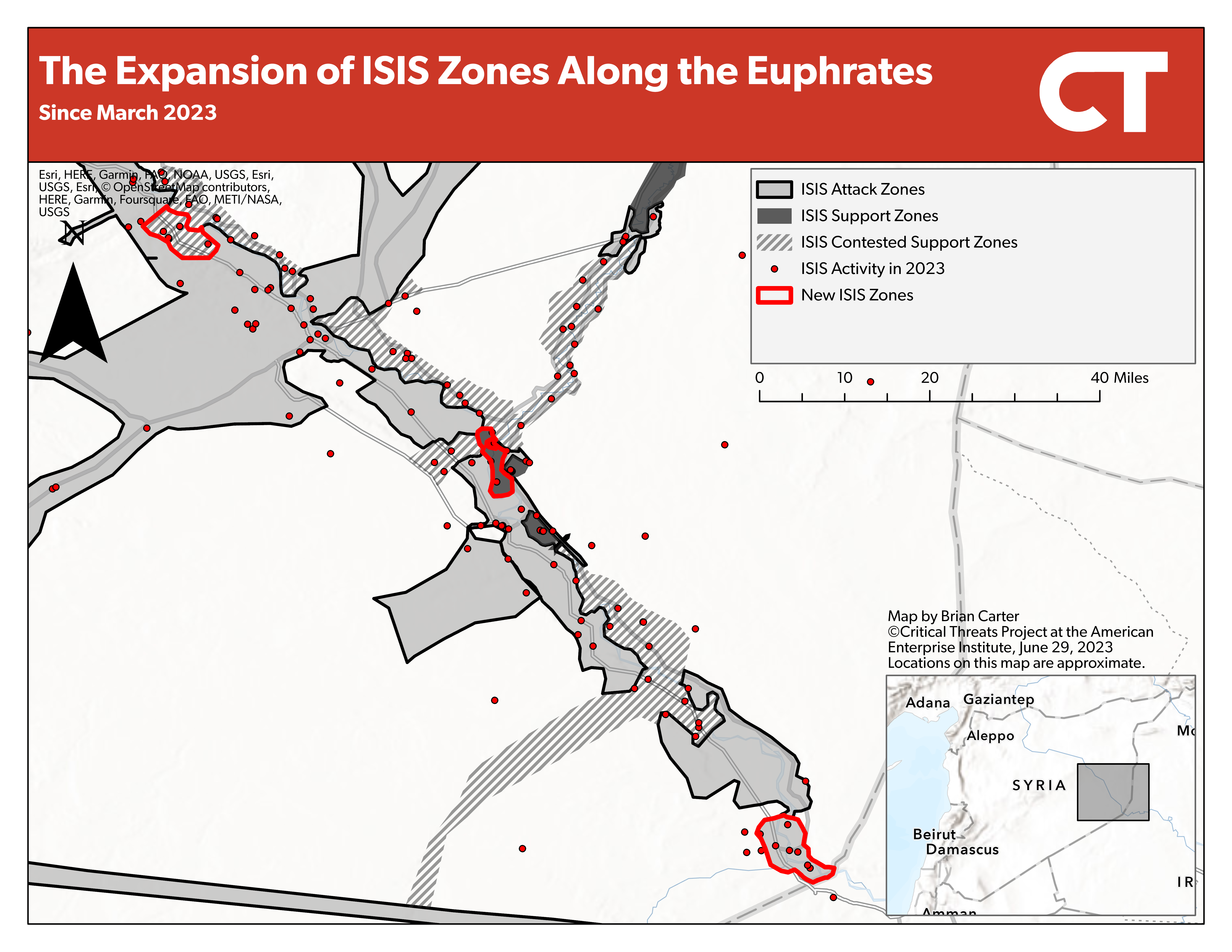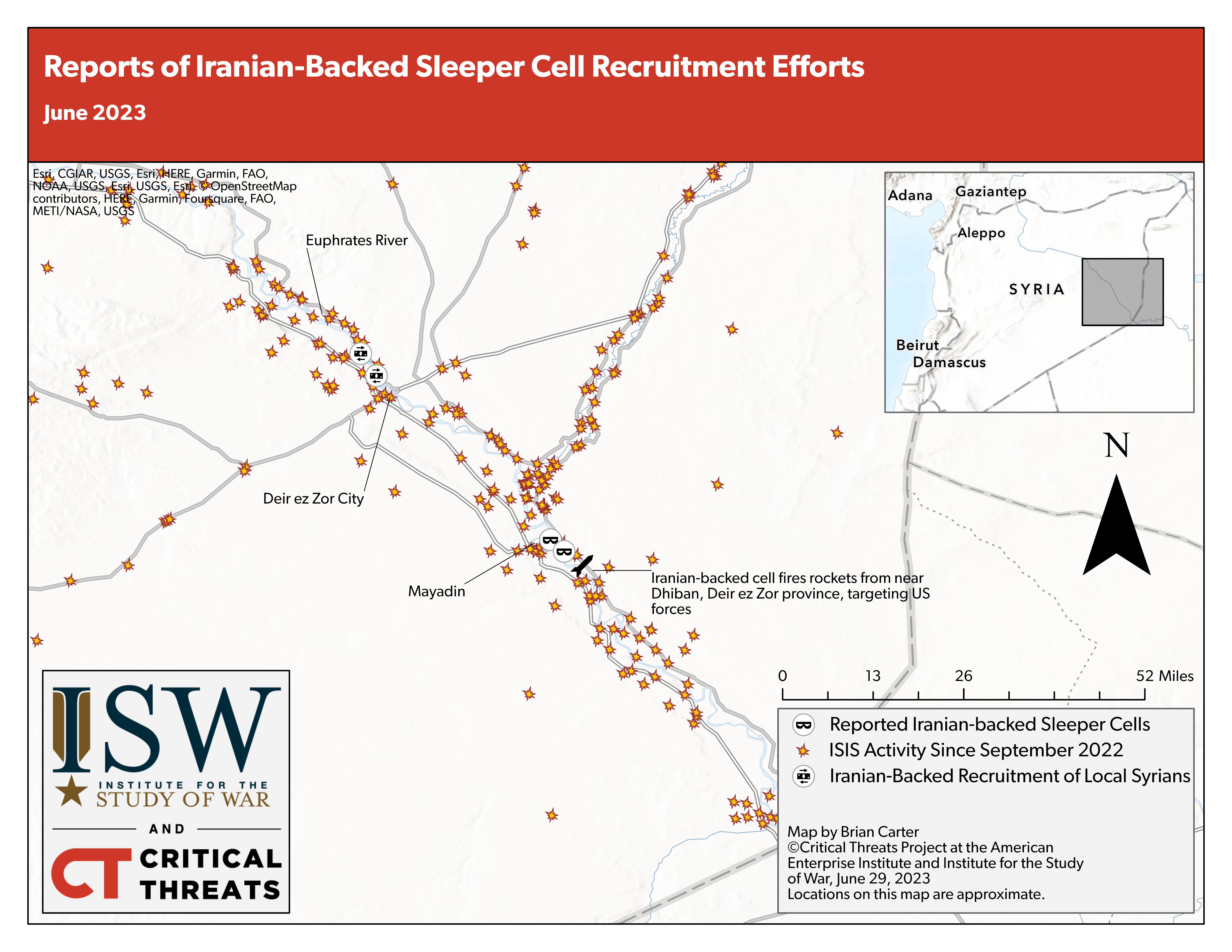{{currentView.title}}
June 30, 2023
Salafi-Jihadi Movement Update Special Edition: ISIS Expands Support and Attack Zones Along the Euphrates River
ISIS has coerced greater support from the population and expanded attack zones along both banks of the Euphrates River, which could present it an opportunity to rebuild sophisticated military capabilities. These capabilities, such as vehicle-borne improvised explosive devices and well-organized attack planning cells, would allow ISIS to generate forces by targeting prisons while also rolling back Syrian Democratic Forces (SDF) control of northeastern Syria.[1] ISIS has not created new support zones along the Euphrates River. The group does, however, have inconsistent access to local populations and key terrain it can use to move forces to and from northeastern Syria and collect intelligence on counter-ISIS forces. ISIS is already attempting to transition these contested areas into support zones. Locals in some areas north of Deir ez Zor city already refuse to move close to regime headquarters or engage with regime forces due to fear of attack.[2]
Figure 1. The Expansion of ISIS Zones Along the Euphrates

Source: Brian Carter.
Deep distrust between pro-regime forces, which sometimes causes clashes and tit-for-tat killings among units ostensibly countering ISIS, has undermined the regime’s ability to counter the group.[3] The regime and Iran also support anti-SDF sleeper cells in northeastern Syria that target the SDF and the United States.[4] This complements ISIS efforts to roll back SDF control of northeastern Syria.
This friction among pro-regime anti-ISIS forces and between pro-regime forces and the SDF prevents their coordination against ISIS. It also precludes deployments to and from areas without creating opportunities for ISIS to expand its influence. The regime and SDF frequently fight each other over control of smuggling along the Euphrates River, which discourages cooperation on countering ISIS movements across the river.[5] ISIS uses these movements to evade counterterrorism pressure from anti-ISIS forces.
Increased competition between pro-regime forces allowed ISIS to expand attack zones near Albu Kamal city, Syria, in May after it conducted zero attacks between October 2022 and February 2023.[6] ISIS similarly expanded its contested support zones north of Deir ez Zor city during March 2023, after competition over smuggling and local frustrations over lack of security against ISIS between the 4th Syrian Arab Army Division and local militias forced a poorly executed transfer of authority between the 4th Division and 17th Syrian Arab Army Division.[7] The poor transfer of authority allowed ISIS to intimidate the population. Syrian media outlet NPASyria reported that ISIS “controls the night” in Musayrib, a town north of Deir ez Zor affected by the transfer of authority.[8]
Figure 2. Reports of Iranian-Backed Sleeper Cell Recruitment Efforts

Source: Brian Carter and Institute for the Study of War.
ISIS has infiltrated pro-regime National Defense Forces (NDF) sleeper cells to resupply its cells, and it may infiltrate Iranian-backed sleeper cells in northeastern Syria for the same purpose and to gain access to more-sophisticated systems. The regime has already established NDF sleeper cells in northeastern Syria, recruiting some of the cells’ members through the reconciliation process.[9] ISIS infiltrated these reconciliation efforts, which enabled the group to gain access to NDF sleeper cells’ weapon caches, which ISIS infiltrators use to resupply ISIS cells.[10] Local Syrian media reported that Iran recruited local Syrians through local intermediaries and “agents” for “sleeper cells” in SDF territory.[11] Iran has provided explosively formed penetrators (EFP) to some of the Syrians it has recruited for attacks against US forces in Syria.[12] Al Qaeda in Iraq gained access to EFPs after Iran smuggled them to its proxies in Iraq during the 2000s.[13]
The establishment of Iranian-backed sleeper cells to attack US forces in northeastern Syria could create opportunities for ISIS to strengthen itself there. The US counter-ISIS mission in Syria said in March 2023 that Iranian attacks against US forces result in “increased force protection requirements” and cause the mission to “reallocate [intelligence] assets to monitor [Iranian] threats.”[14] Counter-ISIS operations paused for 24 hours after Iranian-backed attacks against US forces killed a US contractor and wounded 25 US service members on March 23–24.[15] Iranian attacks against US forces in Syria that cause casualties could put the continuation of the counter-ISIS mission at risk, according to the US Defense Department’s inspector general.[16]
ISIS and regime-backed sleeper cells conduct attacks on the SDF in northeastern Syria, which undermine SDF control over the local population.[17] Limiting SDF control allows ISIS to create support among the population it can use to access resources required for more-sophisticated attack capabilities, such as vehicle-borne improvised explosive devices. Rolling back SDF control also creates unsecured areas from which Iranian-backed forces can launch attacks, such as Dhiban, Deir ez Zor province. ISIS cells forced SDF units to abandon Dhiban in 2022 and have coerced the population to elicit support.[18] Iranian-backed cells fired rockets targeting US forces from Dhiban in March 2023, highlighting the overlapping threat ISIS and Iran pose to US objectives in Syria.[19]
ISIS is likely to exploit the degradation of SDF control along the Euphrates to establish logistics infrastructure, such as safe houses, to rebuild the capabilities required for prison breaks. This would enable ISIS to continue rolling back SDF control. ISIS has previously launched vehicle-borne improvised explosive devices against Al Hol internally displaced person camp from support zones in Hasakah province.[20]
Iranian-backed forces are likely to exploit the degradation of SDF control along the Euphrates to recruit local Syrians to stage attacks and develop a network of safe houses from which they are better positioned to target US forces. A larger pro-Iran presence in northeastern Syria would allow Iranian-backed forces to collect better intelligence on US forces, thereby improving their ability to target US forces. Positioning sleeper cells closer to US forces helps improve accuracy by decreasing the distance rockets need to be launched toward their targets. Better intelligence on US forces would improve Iran-backed forces’ ability to effectively target US forces with EFPs. Iran has already begun recruiting individuals in northeastern Syria and plans to use EFPs against US forces there.[21]
[1] https://www.criticalthreats.org/analysis/ending-the-us-presence-in-syria-could-cause-a-rapid-isis-reconstitution-and-threaten-core-us-national-security-interests
[2] https://npasyria dot com/151923
[3] https://deirezzor24 dot net/en/fourth-division-reinforcements-have-reached-al-bukamal-after-the-recent-skirmishes; https://nahermedia.net/%d8%a7%d8%ad%d8%aa%d9%82%d8%a7%d9%86-%d9%88%d8%aa%d9%87%d8%af%d9%8a%d8%af%d8%a7%d8%aa-%d9%85%d8%aa%d8%a8%d8%a7%d8%af%d9%84%d8%a9-%d8%a8%d9%8a%d9%86-%d8%a7%d9%84%d9%81%d8%b1%d9%82%d8%a9-%d8%a7%d9%84; https://www.syriahr dot com/%D9%84%D8%AE%D9%84%D8%A7%D9%81-%D8%A8%D9%8A%D9%86%D9%87%D9%85-%D8%B9%D9%84%D9%89-%D8%A7%D9%84%D8%AA%D9%80-%D9%80%D9%87%D9%80-%D9%80%D8%B1%D9%8A%D9%80-%D9%80%D8%A8-%D8%A3%D9%85%D9%80-%D9%80%D9%86/589344
[4] https://www.criticalthreats.org/analysis/iran-update-june-13-2023; https://www.crisisgroup.org/middle-east-north-africa/east-mediterranean-mena/syria/containing-resilient-isis-central-and-north
[5] https://www.mei.edu/publications/divided-syria-examination-stabilization-efforts-and-prospects-state-continuity; https://orient-news dot net/ar/news_show/203385
[6] Author’s research.
[7] https://www.criticalthreats.org/analysis/salafi-jihadi-movement-weekly-update-march-22-2023
[8] https://npasyria dot com/151923
[9] https://www.crisisgroup.org/middle-east-north-africa/east-mediterranean-mena/syria/containing-resilient-isis-central-and-north
[10] https://www.crisisgroup.org/middle-east-north-africa/east-mediterranean-mena/syria/containing-resilient-isis-central-and-north
[11] https://www.criticalthreats.org/analysis/iran-update-june-13-2023
[12] https://www.washingtonpost.com/world/2023/06/01/discord-leaks-iran-russia-syria
[13] https://www.understandingwar.org/sites/default/files/reports/Iran%20and%20Al-Qaeda%20in%20Iraq.pdf
[14] https://www.dodig.mil/Reports/Lead-Inspector-General-Reports/Article/3380832/lead-inspector-general-for-operation-inherent-resolve-i-quarterly-report-to-the/
[15] https://www.dodig.mil/Reports/Lead-Inspector-General-Reports/Article/3380832/lead-inspector-general-for-operation-inherent-resolve-i-quarterly-report-to-the/
[16] https://www.dodig.mil/Reports/Lead-Inspector-General-Reports/Article/3380832/lead-inspector-general-for-operation-inherent-resolve-i-quarterly-report-to-the/
[17] https://www.crisisgroup.org/middle-east-north-africa/east-mediterranean-mena/syria/containing-resilient-isis-central-and-north; https://cadmus.eui.eu/handle/1814/74418; https://deirezzor24 dot net/en/the-assad-regime-plans-to-carry-out-assassinations-in-the-sdf-areas; https://www.iswresearch.org/2020/08/anti-isis-coalition-begins-losing.html
[18] https://cadmus.eui.eu/handle/1814/74418; https://npasyria dot com/143361/; https://www.syriahr dot com/en/294325
[19] https://www.syriahr dot com/en/293074
[20] https://twitter.com/DeirEzzore/status/1608751217710333952; https://twitter.com/DeirEzzore/status/1608431882798088193; https://www.centcom.mil/MEDIA/STATEMENTS/Statements-View/Article/3167612/us-central-command-statement-on-thwarted-suicide-bomber-attack-near-um-fakik-vi/
[21] https://www.criticalthreats.org/analysis/iran-update-june-13-2023; https://www.washingtonpost.com/world/2023/06/01/discord-leaks-iran-russia-syria
